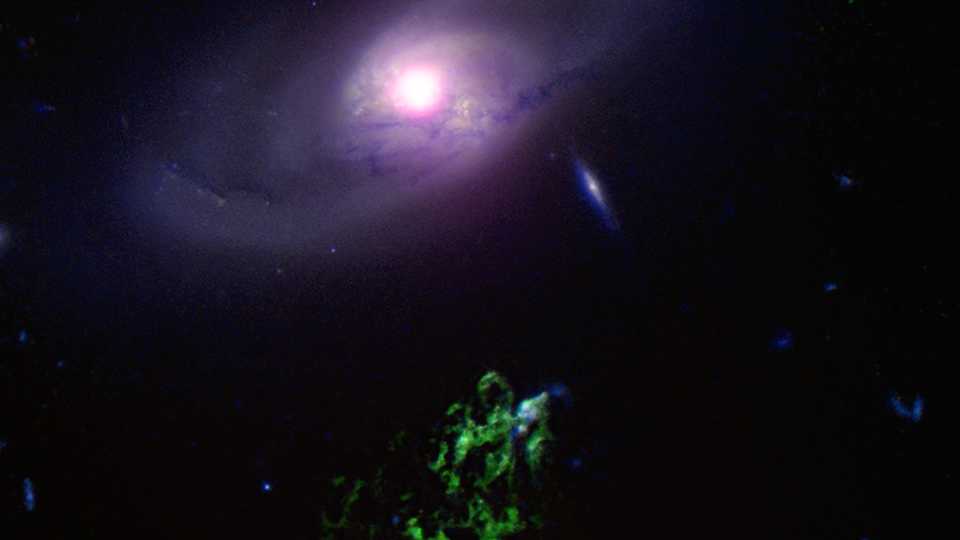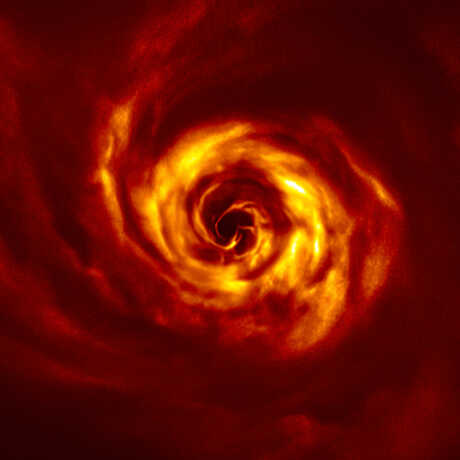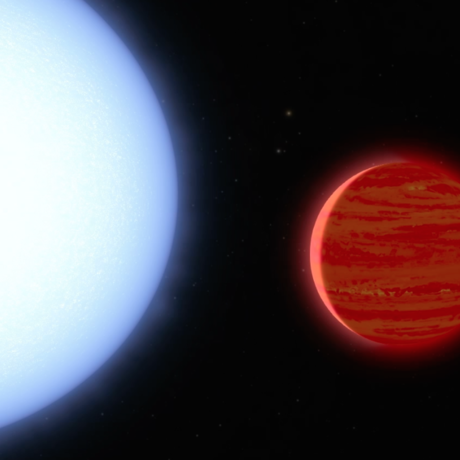Science News
Returned Rockets, Planet Pairs, Habitable Venus, and Brown Dwarfs

Black hole in IC 2497 giving Hanny’s Voorwerp its glow
SpaceX’s Used-Rocket Garage is Full
Following a spectacular nighttime launch on August 13, SpaceX lofted a Japanese communication satellite to a geostationary transfer orbit (GTO), then for the sixth time successfully landed a Falcon 9 first stage onto the Autonomous Spaceport Drone Ship (ASDS) “Of Course I Still Love You”—a bull's-eye landing that’s becoming routine for the private space company.
Ocean landings are not just a headline-grabbing stunt—they’re a critical part of SpaceX’s booster recovery procedure. Launches to higher orbits such as GTO require greater speed than do those to low-Earth orbit (LEO). This means that at main engine cutoff, the rockets are much farther along on their trajectories than they would be if they were simply heading for lower, closer targets such as the International Space Station. At that point, the spent boosters don’t have enough fuel to turn around and fly back to Cape Canaveral. However, they can essentially drop straight down to a point below where first stage separation takes place, and for launches from Cape Canaveral, that’s a few hundred miles off the East Coast in the Atlantic Ocean, where the ASDS is waiting. According to CEO Elon Musk, about half of SpaceX’s launches—those headed for GTO—will involve ocean landings, while those destined for LEO will return for land-based touchdowns in Florida.
After six landings, SpaceX has a hangar full of used rockets, and the company has decided which of them will be the first to fly again. They’ve selected the one that boosted the eighth Commercial Resupply Services (CRS-8) mission to the Space Station in April and made the first successful ocean landing. It and other boosters that flew to LEO were subjected to the least amount of stress during reentry and landing, so they’re in the best shape to fly again. The rocket is undergoing tests to make sure that it’s flightworthy, and its relaunch is currently expected to be scheduled for sometime this fall, achieving SpaceX’s goal of rocket reusability. –Bing Quock
Planetary Pairings
The past few weeks have been a great time to observe the planets just after sunset, starting with all five naked-eye worlds visible simultaneously at the beginning of the month. Then, as the “wandering stars” (as planets were once called) continue in their apparent meanderings against the constellations, they’ll be coming together in other picturesque groupings that occasionally include the Moon.
Most noticeable in the south-southwest at nightfall are the ringed planet Saturn and, just below it, the brighter red planet Mars. Just below them twinkles the bright reddish star Antares, fainter than either planet but still prominent, representing the heart of the constellation Scorpius the Scorpion. This is a good opportunity to make a direct, side-by-side comparison of Mars and Antares and to see why the latter was named after the Red Planet—its name means “rival of Mars” because the reddish colors of both could lead to confusion over which is which (hint, if you don’t have a telescope: Antares twinkles, while Mars doesn’t). Mars is currently moving eastward, while Saturn (being farther away) plods much more slowly against the stars, and Mars will thread the needle between Saturn and Antares, passing between them on August 23-24. Through a medium-size amateur telescope, the disk of Mars is easily visible, as are the magnificent rings of Saturn (and possibly even its largest moon, Titan).
Another pair of planets visible in the sky, low in the west just after sunset, poses a bit more of a challenge. Observers should have as low a western horizon as possible to see them—with no mountains, trees, or skyscrapers in your way. The planets may appear washed from view by the glow of the setting Sun, but these are the two brightest planets in the sky—Venus and Jupiter. As low as they are, they will be distorted by atmospheric turbulence and partly obscured by haze on the horizon, so telescope viewing might be frustrating as they’ll be low in contrast and difficult to keep in focus. Up to about August 25, if you look very carefully to their lower left, you might even spot Mercury. Venus and Jupiter will be closest together on the evening of the 27th, after which Venus continues moving eastward while Jupiter gradually sinks into the twilight.
To keep up with the ever-changing positions of the planets, observable events involving the Sun or Moon, and meteor showers, log on to the quarterly Skywatcher’s Guide on the Academy’s website or download a copy of Morrison Planetarium’s Pocket Almanac. –Bing Quock
Venus, a Previously Potential Habitable World?
When considering planets that may have at one point been possibly habitable in our solar system, Venus is not typically the first world to come to mind. The Venus we know today is not exactly an ideal vacation spot, let alone home, for life. Despite size and composition similar to Earth’s, Venus orbits much closer to the Sun and receives more intense solar radiation, which would have eventually evaporated away any surface water molecules. Without water to help absorb carbon dioxide released by geological activity, a so-called runaway greenhouse effect followed, creating a dense, carbon dioxide-rich atmosphere and surface temperatures close to a blistering 480°C (900°F). That same dense atmosphere also results in pressure on Venus’s surface—90 times greater than that experienced on Earth’s surface (in fact, it’s roughly what you'd experience a kilometer below sea level in our oceans). It was thought that Venus’s thick atmosphere also plays a role in the planet’s extremely slow rotation—one “day” on Venus lasts about 117 Earth days.
But, just as we know that a now desolate Mars used to have a thicker atmosphere and liquid water, Venus too may have once been quite different. A paper published this month in Geophysical Research Letters shows evidence that the second planet from the Sun could potentially have been a habitable world until about 715 million years ago.
Michael Way led a team from NASA’s Goddard Institute for Space Studies (GISS) to simulate the conditions of a hypothetical early Venus, with a couple tweaks—they gave it a thinner, more Earth-like, atmosphere and a shallow ocean that matched data from both NASA’s Pioneer and Magellan missions. A 30 percent reduction in light from the ancient Sun was factored in and Venus’s extremely slow spin was kept the same. The results were a bit surprising.
“In the GISS model’s simulation, Venus’s slow spin exposes its dayside to the sun for almost two months at a time,” explains NASA’s Anthony Del Genio. “This warms the surface and produces rain that creates a thick layer of clouds, which acts like an umbrella to shield the surface from much of the solar heating. The result is mean climate temperatures that are actually a few degrees cooler than Earth’s today.”
Basically, the thinner, more Earth-like atmosphere could have produced the same rotation rate that the planet has today. And with much lower temperatures, cloud cover to shield the planet from intense sunlight, and a shallow ocean, there’s a chance Venus could have been a much more promising place for life. –Elise Ricard
Of Exoplanets and Brown Dwarfs
Not quite stars, not quite planets. Brown dwarfs defy easy classification, in part because they exhibit a broad range of characteristics, dependent on factors that astronomers are still puzzling over.
A recent press release from Carnegie Science describes a new catalog of 152 young brown dwarfs, detailing their observable properties in unprecedented detail. Furthermore, lead author Jacqueline Faherty and her colleagues were able to identify the stellar siblings of many of these brown dwarfs: stars and brown dwarfs are born together in clusters, although they drift apart over time, and identifying stars (and brown dwarfs) moving through space together (even if they’re widely separated) suggests that they came from the same cluster. This common origin means they share many similarities, so associating brown dwarfs with their stellar siblings allowed researchers to pin down the age and chemical composition of the brown dwarfs. Surprisingly, even closely-related brown dwarfs looked very different, likely due to atmospheric effects such as weather or clouds.
Weather and clouds? That sure sounds more like a planet than a star! And indeed, the variation in brown dwarf characteristics could well hint at similar phenomena observed in exoplanets. As Faherty noted, “Brown dwarfs are far easier to study than planets, because they aren’t overwhelmed by the brightness of a host star.” In fact, many of the brown dwarfs’ aforementioned sibling stars host exoplanets, so we know that the processes that formed stars and planets also formed these brown dwarfs. Results from this survey can also help us understand more about giant planets orbiting nearby stars.
The publication is the outcome of years of Faherty’s data collection, a process described in a series of three Science Today articles in 2013 (you can find them here, here, and here), when I accompanied her on one of her many observing nights. –Ryan Wyatt
A Blob and a Bubble Boast a Black Hole
New data from NASA’s Chandra X-ray Observatory and other telescopes offer insight into the activities of a supermassive black hole in a galaxy 650 million light years away. And the objects telling this black hole’s story are an oddly-named green blob and a bubble.
The green blob, called Hanny’s Voorwerp for the citizen scientist who found it, teacher Hanny van Arkel, lies 200,000 light years from the supermassive black hole at the center of galaxy IC 2497. (Ryan Wyatt wrote about the voorwerp several years ago here.) Astronomers think that in the past, a blast of ultraviolet and X-radiation produced by the black hole excited the oxygen atoms in a gas cloud, giving Hanny’s Voorwerp its emerald glow. At present, the black hole is growing too slowly to produce enough radiation to cause such a glow, but given the distance between the black hole and blob, scientists think that we may be observing a delayed response, or an echo of past activity, from a rapidly growing black hole. This past activity would have produced copious amounts of radiation from infalling material, categorizing it as a quasar.
New observations from Chandra show that even though the black hole at IC 2497 is no longer generating intense radiation as a quasar, it is still producing large amounts of energy. In a long exposure by Chandra, the center of the X-ray emission shows cooler gas, which astronomers interpret as a large bubble. Astronomers suspect this bubble may have been created when a pair of jets from the black hole blew away the hot gas. In this scenario, the energy produced by the supermassive black hole has changed from that of a quasar, when energy is radiated in a broad beam, to more concentrated output in the form of aligned jets of particles.
Astronomers believe that clues from blobs and bubbles like these could be a new way to probe the past activity of other black holes and their effects on galaxies. –Molly Michelson


